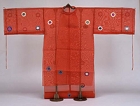Japanese Gallery (Honkan) Room 9
December 26, 2007 (Wed) - February 17, 2008 (Sun)
Bugaku is a type of music with accompanying dance performances that was imported into Japan from continental Asia in the late 8th century. During the Nara (710-794) and Heian (794-1192) periods it developed a style unique to Japan as the official performing art of the imperial court, Buddhist temples and Shinto shrines. This tradition was inherited throughout the medieval and early-modern ages by temples and shrines, as well as court aristocrats in their individual annual events. At the court, which put a special emphasis on customs and manners, the bugaku costumes also reflect a strong traditional flair.
Togaku
-
Chinese style music, generally called saho (left style) preferring red costumes
Komagaku
-
Korean style music, generally called uho (right style) preferring blue costumes.
Depending on the style of the dance, they are classified further as follows:
Hiramai
-
quiet dances involving many dancers, using tsune-type costumes
Bumai
-
martial dances using swords or spears, using bane-type costumes
Hashirimai
-
energetic dances using masks, using ryoto-type costumes
This exhibition introduces bugaku costumes of the medieval and pre-modern periods along these categories, offering an opportunity to enjoy the refined colors and design of the Japanese court culture.

